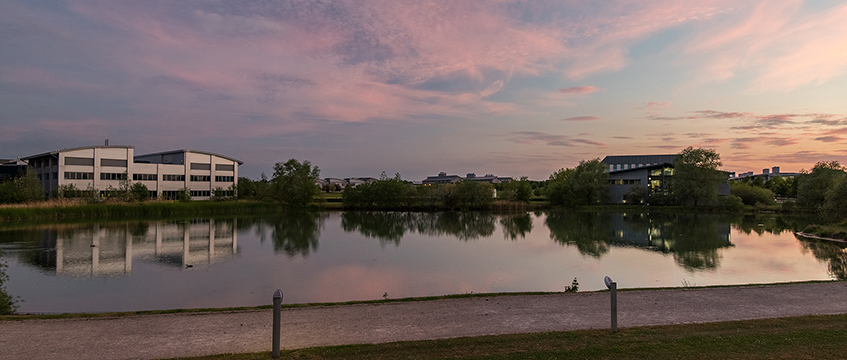Life sciences-related real estate development across the key Golden Triangle markets has intensified in recent years, with 16.8m sq ft of laboratory-led space due to be delivered by the end of 2028, according to DTRE.
The firm predicts about 2.7m sq ft of lab space under construction or being repurposed will hit the market over the next 12 months. Some 685,000 sq ft of existing space was available across all Golden Triangle markets at the end of June, but mostly in Oxford and London. In Cambridge, excluding the southern cluster spanning across Granta Park(pictured), Babraham Research Campus, The Press, and Unity Campus, there is practically no up-and-built laboratory space available for immediate occupation.
As for demand, the most recent data from DTRE has tracked 2m sq ft of named requirements across Cambridge, Oxford and London. However, the firm noted that many requirements have been temporarily put on hold due to wider macroeconomic uncertainties.
With demand continuing to outweigh supply, DTRE expects rental growth to remain strong across the key Golden Triangle markets.
In Oxford, fitted laboratory rents recently hit a new high of £82.50 per sq ft. The record was achieved at the Sherard Building on Oxford Science Park, where Oxford Nanopore leased 13,000 sq ft of fully fitted space.
In Cambridge, several schemes providing fitted space are quoting rents above £70 per sq ft, while fitted laboratory rents in London are predicted to exceed the current headline rent of £120 per sq ft.
Researchers at DTRE said: “We are especially seeing demand for smaller, fully fitted space in London, where we are seeing schemes quote up to £165 per sq ft.”
Understanding the occupier
Since the start of 2024, DTRE has tracked an increase in requirements above 50,000 sq ft in Cambridge, more than in the rest of the Golden Triangle, and now representing 38% of demand in the region. Requirements for smaller, fully fitted laboratories of up to 20,000 sq ft have also continued to grow, representing 20% of demand.
In Oxford, demand continues to be dominated by requirements smaller than 20,000 sq ft, followed by mid-size requirements of between 20,000 sq ft and 50,000 sq ft, while occupiers searching for above 50,000 sq ft of space make up just 13% of the market.
In London, there were just three requirements of more than 50,000 sq ft at the end of June, with the majority of named laboratory demand spread across the small or mid-size space.
According to DTRE, this change in demand profile underscores the importance for developers to provide a variety of fit-out specifications to appeal to the broadest range of occupiers.
Matt Smith, head of science and technology at DTRE, said: “There is currently no straightforward definition of what constitutes ‘fully fitted’. It differs across markets, between landlords and to the occupier’s specific scientific needs. What’s ‘fully fitted’ for one may only be partially fitted for another. Shared facilities and bespoke fit-outs also affect the definition.”
More broadly, a fully fitted laboratory space features vinyl flooring, benching and shelving, provision for recirculating fume cupboards, eye wash stations, lab sink and hand washing facilities, and provision of gases and drainage.
Buildings with fully fitted labs often also contain a shared equipment room, allowing the occupiers to access equipment they may otherwise not be able to afford.
In addition, fully fitted lab spaces are understood to be flexible, often offered on short and fluctuating terms, allowing occupiers to expand and scale up.
These turnkey solutions are understood to be attractive mostly to smaller companies, particularly recent university spinouts which need to progress their research and development quickly, so benefit from being able to get up and running on day one. There is also a cost benefit for smaller firms that take fully fitted space rather than designing bespoke space.
Demand to come live again
According to DTRE, many life sciences and biotech businesses across the Golden Triangle have chosen to remain in their current space until the economy settles.
Although the sluggishness of venture capital funding persisted early in 2024, the result of the general election and improving economic landscape is expected to support the recovery of sentiment and motivate investment. That should encourage businesses that have successfully raised the funds to satisfy their space demands.
Researchers said: “[The funds] will slowly be released as sentiment improves and tenants that have previously put expansion plans on hold reactivate their search.”
Total UK venture capital investment stood at £1.2bn over the first six months of 2024, with London-based life sciences and biotech companies receiving the most funding, at £327m. The figure is 175% ahead of Cambridge and 24% ahead of Oxford, where 46 life sciences and biotech companies raised £119m and 32 firms raised £263m, respectively.
DTRE’s team added: “When considering the maturity of the alternative two markets, these figures exhibit the push led by investors for the growth of the London science and technology markets.”
Source, both charts: DTRE
Send feedback to Evelina Grecenko
Follow Estates Gazette













